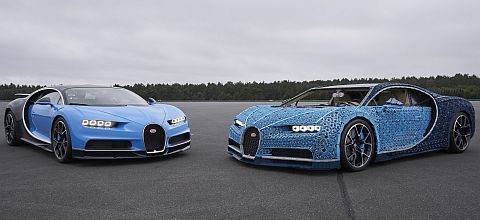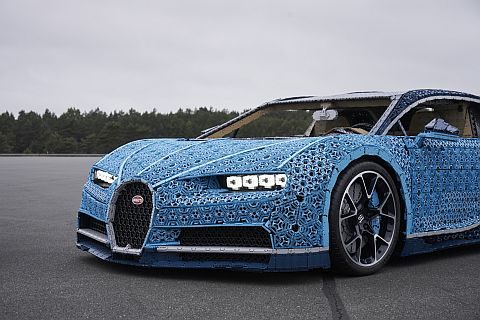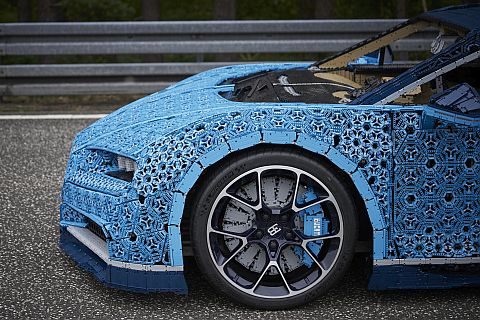Earlier this year, LEGO released the #42083 LEGO Technic Bugatti Chiron, a 1:8 scale replica model of the real luxury sports car, and managed to cram in some of the original features like the aerodynamic bodywork with an active rear wing, spoked rims with low-profile tires, detailed brake discs, W16 engine with moving pistons, 8-speed gearbox with movable paddle gearshift, steering wheel bearing the Bugatti emblem, storage compartment with a stylish Bugatti overnight bag, and more. (You can read more about the set here: LEGO Technic Bugatti Chiron Available Now!) Since then, LEGO built a real, working 1:1 scale replica of the Bugatti Chiron, and even took it to a spin on the same German track where Bugatti does their testing. Below are some details and demonstration videos about this stunning model as well as how it was built. Watch and be amazed! 🙂

The idea to build a real-size 1:1 LEGO Technic version of the Bugatti Chiron originated within the LEGO Technic design team. Designer Aurelien Rouffiange and the team had just completed the 1:8 scale model of the Chiron and began to debate what the ultimate challenge for the LEGO Technic building system would be. A full-size, self-propelled vehicle seemed to provide the toughest test.

If you want to build large-scale models in LEGO elements, then the place to go is the LEGO facility in Kladno in the Czech Republic. These LEGO designers specialize in creating complex models for LEGO stores and LEGOLAND parks around the world. If anyone could make the idea of a full size LEGO Technic Bugatti Chiron a reality, it was them. They quickly put together a core team of 16 specialists, including design, mechanical and electrical experts, and used over 13,000 man-hours creating the car piece by piece.

It’s one thing to dream of creating a 1:1 drivable Bugatti Chiron in LEGO Technic, it’s another to make it actually happen. Months of development and testing came to a head in June on the Ehra Lessien test track outside Wolfsburg, Germany – the same track where the original Bugatti Chiron was tested – when we found out if the car would actually drive. We were even more excited when Bugatti’s official test driver and former Le Mans winner, Andy Wallace, agreed to test-drive the Technic version of the Chiron on its first drive.
To make it clear how amazing this is, the 1:1 LEGO Technic Bugatti Chiron is a fully-functional self-propelled life-size LEGO Technic car. It is also the first non-glued LEGO Technic model of such complexity, the first large model powered using LEGO Technic Power Functions motors, and the first large-scale moving model using LEGO Technic bricks & elements. It is also the first time LEGO created load-bearing parts built purely out of LEGO Technic bricks and elements using 58 types of LEGO Technic custom-made parts. LEGO also made new types of transparent LEGO Technic bricks to build the lights of the car. Here are some facts and numbers:
- Over 1,000,000 LEGO Technic elements in total
- 339 types of LEGO Technic elements used
- No glue used in the assembly
- Total weight: 1,500 kg
- Engine contains: 2,304 LEGO Power Functions motors, 4,032 LEGO Technic gear wheels, and 2,016 LEGO Technic cross axles.
- Theoretical performance of 5.3 HP
- Estimated torque of 92 Nm
- Functional rear spoiler (using both LEGO Power Functions and pneumatics)
- Functional speedometer built entirely from LEGO Technic elements
- 13,438 man-hours used on development and construction
To get the full story behind the creation of this amazing real-size LEGO Technic version of the Bugatti Chiron, LEGO released a second video, where you can learn how the engineers and the designers overcame challenge after challenge to recreate the real Chiron – and make it drive using only LEGO Power Function motors!
What I like the most about the life-size LEGO Technic Bugatti Chiron is the beautiful honeycomb style skin. The flexible design doesn’t just allow to recreate all the subtle curves of the Bugatti, but it is also stunningly beautiful and artistic. And look at all those LEGO Power Functions motors, gears, and translucent LEGO Technic pieces! This is like a LEGO Technic builder’s dream!

I don’t know what LEGO is planning to do with the Chiron now that it is built, but it would be wonderful if they would take the car on a world tour and show it off at different locations. This is a model that many LEGO fans would love to spend time checking out personally. As a second best option, you can also take a look at the #42083 LEGO Technic Bugatti Chiron at the LEGO Technic section of the Online LEGO Shop.

What do you think? How do you like the life-size LEGO Technic Bugatti Chiron? Are there any interesting details that you noticed from the videos? Feel free to share and discuss in the comment section below! 😉
And you might also like to check out the following related posts:












I’ve tried to find if it has a metal frame, but couldn’t tell. If it doesn’t than OMG thats some clutch power
In the video they show the car has a metal frame, but it’s very minimal, just to connect the wheels. The rest is Technic and Power Functions. Really amazing!
It is a huge step to show others that lego can really do stuff that they will be amazed by. I would allready be impressed by the car it self, they didn’t have to get it driving. The fact that you can even open the doors and on the lights, and not to forget open that thing at the back is already amazing on itself, along with the fact that they look so similair.
On the flip side, How much Kilometers per Hour can this thing go? Probably not nearly enough to compete with the real bugatti chiron.
Oh and about how much does the lego version cost, and what does the real version cost?
What is the difference in price, and which one has a better value? Not that I am seriously thinking about building it, but still would be interesting to know if a lego car outvalues a real car in kph per euro.
The article on Wired mentions that the LEGO version of the Chiron can go 18 MPH. They don’t mention the price though: “…the specs don’t exactly match the original. Where the real Chiron produces 1,500 horsepower from a quad-turbocharged W16 engine and can hit 261 mph, the Lego lookalike makes 5.3 horses from 2,304 tiny motors and can go 18 mph—surely the slowest any vehicle has driven at Germany’s Ehra Lessien proving ground. But the resemblance is uncanny.” https://www.wired.com/story/lego-bugatti-chiron/
Oh ok, so that is 30 kmph that is still faster then me cycling, so I would still use it to got to school, not to mention it looks a lot more classy. It is probably pretty painful though, since the interior is made out of lego bricks (including the steering wheel, chair and the pedal), and I am just 15 and in the Netherlands you need to be 18 to get a driving license… 😀
I might actually try to calculate about how much it costed in bricklink prices, since I have found the numbers of pieces.
Maybe you can put in a pillow to cover the seat? 😀
As far as the price, keep in mind that many of the pieces are custom made specifically for this car. You might calculate some BrickLink average for them, but that may not be accurate at all. AFOLs would kill for translucent LEGO Technic pieces! 😈
Nice geometric pattern there on the Bugatti build. Looks like the roof on some Greek or Islamic building…
Yeah, I really like the pattern too. To me it looks like a beehive, but I accept your interpretation also. One of our readers on Facebook said it reminds him of a crocheting pattern. Like grandma crocheted a whole car. 😀
Hehe! I can see that, now when you mention it.
(Or at least a car cover…)
Awwww! A crocheted blanky! LOL! I can see that! 😀
I think this is just incredible. What an engineering feat, and it looks gorgeous. I am stunned they were able to replicate the sleep lines so well. Just too awesome.
Yeah, tell me about it! It’s so beautiful! 😀
This is amazing. I can’t stop looking at it. I hope they will take it on a world tour!
Hm… that would be great! 😀
I can’t get over how beautiful this is. I would love to see it in real life! What is the top speed? Do we know? I didn’t see that listed in the stats.
I mentioned that in response to another comment. It’s 18 MPH. Yeah, not exactly super car speed, but I think it still makes LEGO fans happy. 😀
I guess that’s about 40 km/h, in Metric…
Or perhaps 30 km/h, rather…
An online calculator indicates 29 km/h is a good enough approximation for most regular usage…